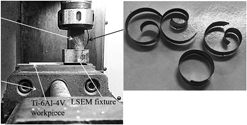Crossref Citations
This article has been cited by the following publications. This list is generated based on data provided by
Crossref.
Bai, Jinxuan
Bai, Qingshun
Tong, Zhen
and
Guo, Hui
2018.
Theoretical model for subsurface microstructure prediction in micro-machining Ti-6Al-4V alloy – Experimental validation.
International Journal of Mechanical Sciences,
Vol. 148,
Issue. ,
p.
64.
Yin, Xiaolong
Pi, Yunyun
He, Di
Zhang, Jiayang
and
Deng, Wenjun
2018.
Development of ultrafine grained Al 7075 by cryogenic temperature large strain extrusion machining.
Journal of Materials Research,
Vol. 33,
Issue. 20,
p.
3449.
Yin, Xiaolong
Chen, Haitao
and
Deng, Wenjun
2019.
Effects of Machining Velocity on Ultra-Fine Grained Al 7075 Alloy Produced by Cryogenic Temperature Large Strain Extrusion Machining.
Materials,
Vol. 12,
Issue. 10,
p.
1656.
Mishra, Vagish D.
Palaniappan, Karthik
Rao, Balkrishna C.
and
Murthy, H.
2020.
TMS 2020 149th Annual Meeting & Exhibition Supplemental Proceedings.
p.
2113.
Bhardwaj, Akhil
Gohil, Naishadh
Gupta, Amit Kumar
and
Kumar, S.S. Satheesh
2021.
An experimental investigation on the influence of elevated-temperature constrained groove pressing on the microstructure, mechanical properties and hardening behaviour of Ti6Al4V alloy.
Materials Science and Engineering: A,
Vol. 802,
Issue. ,
p.
140651.
Gurusamy, Muralimohan
Palaniappan, Karthik
Murthy, H.
and
Rao, Balkrishna C.
2021.
A Finite Element Study of Large Strain Extrusion Machining Using Modified Zerilli–Armstrong Constitutive Relation.
Journal of Manufacturing Science and Engineering,
Vol. 143,
Issue. 10,
Kumar, Pushpinder
Joshi, Ravinder Singh
and
Singla, Rohit Kumar
2021.
Sliding wear behaviour of CP titanium laminates produced by large strain extrusion machining.
Wear,
Vol. 477,
Issue. ,
p.
203774.
Ping, Zhang
Penghao, Wang
Xiujie, Yue
Yanchun, Zhai
and
Xiao, Yu
2022.
Influence of tool geometric parameters on the residual stress of 7A04 aluminum alloy in LSEM.
The International Journal of Advanced Manufacturing Technology,
Vol. 120,
Issue. 3-4,
p.
1707.
Palaniappan, Karthik
Sundararaman, M.
Murthy, H.
Jeyaraam, R.
and
Rao, Balkrishna C.
2022.
Influence of workpiece texture and strain hardening on chip formation during machining of Ti–6Al–4V alloy.
International Journal of Machine Tools and Manufacture,
Vol. 173,
Issue. ,
p.
103849.
Kumar, Pushpinder
Joshi, Ravinder Singh
and
Singla, Rohit Kumar
2023.
Investigation of tribological and metallurgical effects on Ti–6Al–4V laminates made by LSEM for Ti/GFRP stacked composite.
Wear,
Vol. 524-525,
Issue. ,
p.
204860.
Gurusamy, Muralimohan
and
Rao, Balkrishna C.
2023.
A Comprehensive Review of Large-Strain-Extrusion Machining Process for Production of Fine-Grained Materials.
Crystals,
Vol. 13,
Issue. 1,
p.
131.
Singh, Arshpreet
2024.
Surface integrity of pure titanium strips produced by large strain extrusion machining at varying speeds.
Sādhanā,
Vol. 49,
Issue. 3,
Palaniappan, Karthik
Murthy, H.
and
Rao, Balkrishna C.
2024.
On suppression of chip segmentation during cutting of Ti–6Al–4V alloy through control of texture rather than ductility.
Journal of Materials Research,
Vol. 39,
Issue. 15,
p.
2131.




